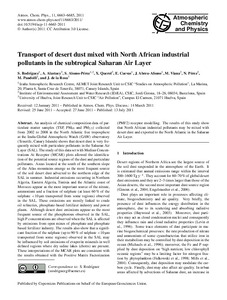Por favor, use este identificador para citar o enlazar este ítem:
http://hdl.handle.net/20.500.11765/416
Transport of desert dust mixed with North African industrial pollutants in the subtropical Saharan Air Layer
| Título : | Transport of desert dust mixed with North African industrial pollutants in the subtropical Saharan Air Layer |
| Autor : | Rodríguez González, Sergio





|
| Palabras clave : | Desert dust; Industrial pollutants; Saharan Air Layer; Partículas de polvo; Contaminantes atmosféricos |
| Fecha de publicación : | 2011 |
| Editor: | European Geosciences Union |
| Citación : | Atmospheric Chemistry and Physics. 2011, 11(13), p. 6663-6685 |
| Versión del editor: | http://dx.doi.org/10.5194/acp-11-6663-2011 |
| Resumen : | An analysis of chemical composition data of particulate matter samples (TSP, PM10 and PM2.5) collected from 2002 to 2008 in the North Atlantic free troposphere at the Izaña Global Atmospheric Watch (GAW) observatory (Tenerife, Canary Islands) shows that desert dust is very frequently mixed with particulate pollutants in the Saharan Air Layer (SAL). The study of this data set with Median Concentrations At Receptor (MCAR) plots allowed the identification of the potential source regions of the dust and particulate pollutants. Areas located at the south of the southern slope of the Atlas mountains emerge as the most frequent source of the soil desert dust advected to the northern edge of the SAL in summer. Industrial emissions occurring in Northern Algeria, Eastern Algeria, Tunisia and the Atlantic coast of Morocco appear as the most important source of the nitrate, ammonium and a fraction of sulphate (at least 60 % of the sulphate <10 μm transported from some regions) observed in the SAL. These emissions are mostly linked to crude oil refineries, phosphate-based fertilizer industry and power plants. Although desert dust emissions appear as the most frequent source of the phosphorous observed in the SAL, high P concentrations are observed when the SAL is affected by emissions from open mines of phosphate and phosphate based fertilizer industry. The results also show that a significant fraction of the sulphate (up to 90 % of sulphate <10 μm transported from some regions) observed in the SAL may be influenced by soil emissions of evaporite minerals in well defined regions where dry saline lakes (chotts) are present. These interpretations of the MCAR plots are consistent with the results obtained with the Positive Matrix Factorization (PMF2) receptor modelling. The results of this study show that North African industrial pollutants may be mixed with desert dust and exported to the North Atlantic in the Saharan Air Layer. |
| Patrocinador: | This study has been carried out within the Global Atmospheric Watch Program (financed by AEMET), and in the framework of the research projects GRACCIE (CSD2007- 00067; Ministry of Science and Innovation of Spain), CARIATI (CGL2008-06294/CLI; Ministry of Science and Innovation of Spain), AER-REG (P07-RNM-03125; Department of Innovation, Science and Enterprise of the Government of Andalusia) and REDMAAS (CGL2010-11095-E; Ministry of Science and Innovation of Spain). |
| URI : | http://hdl.handle.net/20.500.11765/416 |
| ISSN : | 1680-7316 1680-7324 |
| Colecciones: | Artículos científicos 2010-2014 |
Ficheros en este ítem:
| Fichero | Descripción | Tamaño | Formato | ||
|---|---|---|---|---|---|
| acp-11-6663-2011.pdf | 6,91 MB | Adobe PDF |  Visualizar/Abrir |
Este ítem está sujeto a una licencia Creative Commons Licencia Creative Commons






